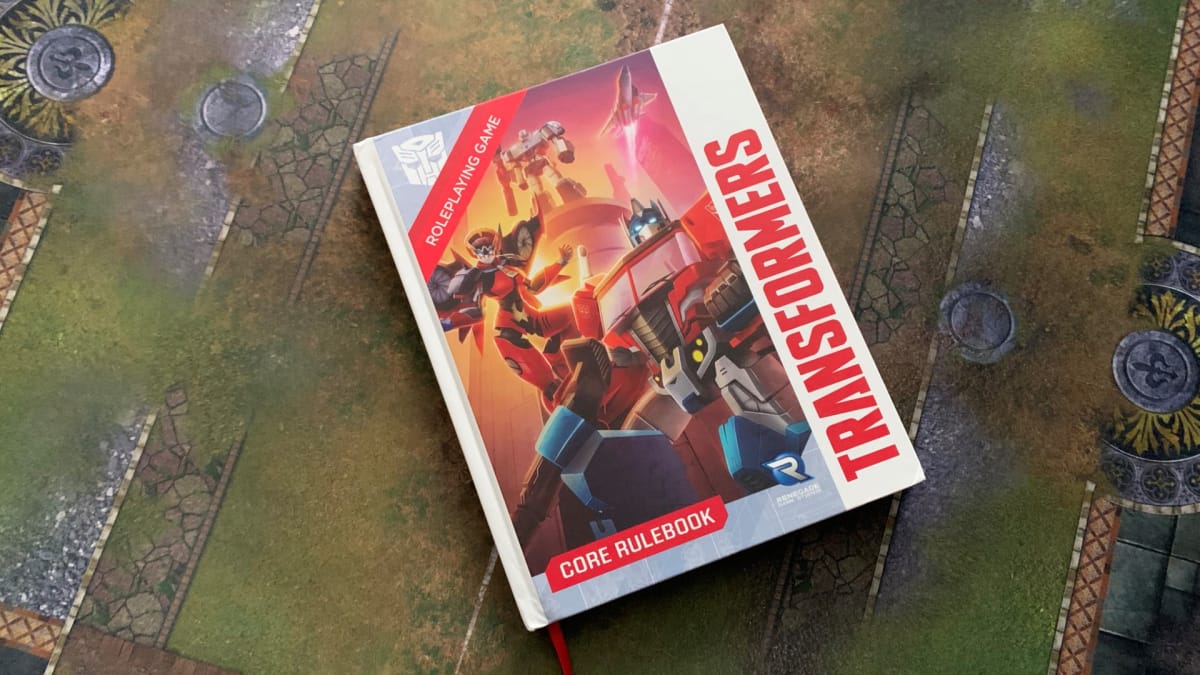My time with Transformers: The Roleplaying Game was an utter delight. Not only was it an exercise in nostalgia, it was a chance to put my own spin on the war drama of transforming giant robots with my friends. Finally, it manages to embody the spirit of a series that started as a promotion for toys with a gimmick into an enduring sci-fi universe.

How Does Transformers: The Roleplaying Game Feel To Play?
Transformers: The Roleplaying Game is the third TTRPG that uses Renegade Game Studios' Essence20 system. That fundamental core remains the same. Your characters stats are broken up across four different Essence scores: Strength, Speed, Smarts, and Social. Your experience in a skill doesn't provide number bonuses to a roll, but lets you roll increasingly higher faces of dice and adding the results to a d20 skill roll. Furthermore, there are unique armor and weapon traits as well as dynamic actions that can allow for additional dice rolls.
Because of this, Transformers: The Roleplaying Game always has an air of excitement when each and every dice roll happens. Since a lot of skill challenges rely on swings of chance, a lot of unexpected twists and turns can happen. A major villain with an extremely high skill die can still roll all 1s and fail. A PC with a bit of forethought and some know-how can swing wildly out of their weight class and turn the tide of a fight.
As for what Transformers: The Roleplaying Game brings to the table, part of it is in the name. Every single character in this game has two different forms. Their Bot Mode is their bipedal robot form where they can use certain weapons and gear. Then there is the Alt mode, which is the vehicle they change into. The latter is interesting since there's a whole section where you can customize this Alt mode with additional benefits. These include having first-aid supplies in the trunk to aid with Medicine rolls, or having tank treads to ignore rough terrain.
Second, there are Energon Points. These can be spent to give players temporary boosts to skill rolls and given to teammates. But the biggest draw is that they can be spent once your character hits 0 health, which will allow them to stay active in a battle for a few more turns. Since Transformers are robots, losing limbs or suffering agonizing pain is more of an inconvenience in comparison to more human characters. Because of this, being able to keep going after getting shot in the gut or having half of your face blasted off by laser fire fits this property perfectly.
Finally, Transformers: The Roleplaying Game doesn't neglect the fact that the PCs are alien beings trying to integrate into Earth society. While the Transformers series is known for larger than life battles and tales of heroic sacrifice – I have strong personal nostalgia for the 2000s Unicron Trilogy for that reason – this TTRPG addresses the "robots in disguise" angle. This can lead to a more humanistic approach to a game with Autobot PCs shadowing certain human characters and becoming weirdly attached to their different ways of life. Not only is this great for roleplaying interludes, it can give some strong character moments whenever a Decepticon scheme leads to collateral damage.

What are the Player Options for Transformers: The Roleplaying Game?
When it comes to player options, Transformers: The Roleplaying Game has plenty of variety. Like all other Essence20 TTRPG systems, character creation is broken up into several categories. Your Origin is how your Transformer was forged and determines your starting health as well as your Alt Mode. Next, your Influences gives your character a lived history, something they were involved in before the Cybertronian Civil War broke out. The options include things like Bureaucrat, Cube Player, or War Veteran and provide in-game benefits.
Finally, your Role determines what sort of archetype you'll fall into when the action starts. Analysts are all about exploiting enemy weaknesses; both on the battlefield and in their security measures. Field Commanders are battlefield tacticians and negotiators. They are all about supporting their allies and coordinating ceasefires. Gunners and Warriors are all about combat, either filling them with heated slag from a distance or chopping them into scrap with energon weapons. Scientist is the team's field medic and gadget specialist. Scouts are infiltration and recon units. Finally, Modemaster is a jack-of-all-trades Role that can quickly move between different modes.
Like GI Joe: The Roleplaying Game, each of these Roles have different Focuses or subclasses. Each of them function as extensions of the Role's appeal. For example, the Modemasters choose between the flexible mobility options of a Triple Changer, or having their own minicon companions on hand for back-up with Microlinked. Gunners can choose between spraying and praying as a Gunslinger or the more considered elegance of a long-range rifle with Sharpshooter.
The only real hiccup to character creation in Transformers: The Roleplaying Game is with armor upgrades. Much like past games using the Essence20 system, there is no in-game economy. If you want to upgrade your weapons or get an armor upgrade for your Autobots chassis, you have to have training in a certain tier of weapon or armor upgrade (Standard, Limited, Restricted, etc.). Several of these Roles state that you are trained in Standard armor upgrades, but the Core Rulebook has no Standard upgrades listed. It's a concerning oversight since it leads to a weird power gap in early levels.

How Easy Is It To Run Transformers: The Roleplaying Game?
As for those planning to GM Transformers: The Roleplaying Game, the core rulebook does provide a solid foundation. First, the book does embody a lot of the tropes and storytelling elements the series is known for. This includes Human/Cybertronian politics, how vital the creation of energon is to Transformers life, and the franchise's tendency to gloss over size proportion or preservation of mass.
Furthermore, the core rulebook is packed with devilish Decepticon threats. These include classics like Soundwave, Starscream, and Megatron, as well as a few welcome additions such as Cyclonus' Scourge Drones or the sadistic Airachnid. The only real omissions appear to be combiner teams like the Constructicons or more esoteric threats like the Quintessons or The Fallen. But that is where supplements and some GM homebrew know how come into play.
As for running these various combat encounters, there is a lot of excitement that comes from it. Each character in Transformers has a lot more combat options when it comes to healing and resistances, which can make various scenarios feel like hard fought battles of attrition. Because of this, there's more of an emphasis on smaller groups of enemies with more perks and armor upgrades when compared to GI Joe's battalions of Cobra Troopers or Power Rangers' single giant monster with area control effects.
Plus, having various alt modes leads to a lot of dynamic battles which can lead to a dogfight, then a navel battle, then to a pitched gunfight in the trenches. A lot can happen in just one fight and it's a testament to the game's systems that both the players and the GM aren't completely lost.
There are some formatting issues with Transformers: The Roleplaying Game. Some of these are minor typos found throughout the book. Most of these are extremely minor and don't really detract from the overall package. But there are some regarding weapon and armor traits that can confuse new GMs. Case and point, I have run adventures across three different RPGs using this system, and I am still unclear on the benefits of the Deflective armor trait. This doesn't mean this core rulebook needs a second printing, but it is something errata will have to address.

Should I Buy Transformers: The Roleplaying Game?
Formatting issues aside, I highly recommend Transformers: The Roleplaying Game. The core rulebook allows for a wide variety of Autobot characters as well as a foundation for GMs to tell their own stories. Finally, the inclusion of alt modes, energon, and other franchise trappings are integrated very well. If you wanted to make your very own robot in disguise, pick this book up. 'Til all are one.
The copy of Transformers: The Roleplaying Game used in this review was provided by the publisher.
Review Summary
Have a tip, or want to point out something we missed? Leave a Comment or e-mail us at tips@techraptor.net













